Passchendaele
First World War
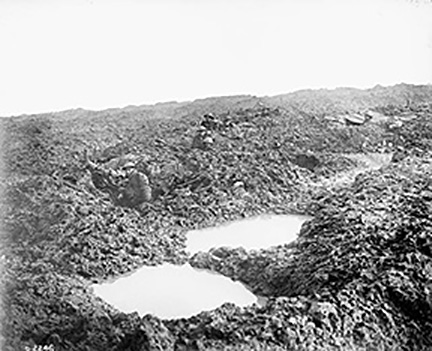
Personnel of the Canadian Machine Gun Corps holding the line in shell holes during the Battle of Passchendaele. The machine-gunner closest to the camera is Private Reginald Le Brun. November, 1917.
Credit: William Rider-Rider/Library and Archives Canada/PA-002162 (MIKAN no. 3233069)
Date
26 October – 10 November 1917
Geographical parameters
The Comines-Ypres canal as far as Voormezeele; thence road to Vlamertinghe Château – Elverdinghe Château – Woesten – Bixschoote
Context
A battle honour formally entitled “Second Battle of Passchendaele” and itself forming part of “The Battles of Ypres, 1917”.Footnote 1
Description
The Honour “Passchendaele” was awarded for the final phase of the 1917 campaign in Flanders. The period covering the honour began on 12 October 1917 as British, Australian and New-Zealand troops began the assault with a view to taking the high ground on which the village of Passchendaele was located. These attacks made little progress. The Canadian Corps was ordered to Flanders at the beginning of October and by the middle of the month preparations, including building and improving roads, were under way. Special attention was paid to locating and repairing artillery positions. The Canadian Corps (Lieutenant-General Sir A.W. Currie) began taking over from the Australians on 18 October as preparations continued. The Canadian plan was to move along the high ground of the Bellevue Spur west of Passchendaele on the left of the Corps area. On the Corps right the attack would be towards the high ground where the village of Passchendaele was located. The centre of the Corps was split by the valley of the Ravebeek, a small course of water that had flooded all the low ground making it almost impassable. The attack would be conducted in three phases and an artillery plan was devised to mislead the Germans as to the actual time of the attack. This first attack was launched on 26 October with the 3rd Division (Major-General L.J. Lipsett) on the left, assaulting the Bellevue Spur, and the 4th Division (Major-General Sir D. Watson) on the right towards Passchendaele. The 4th Division's initial assault was successful in taking their objectives, and although the Germans launched strong counter-attacks the Canadians held on over the next few days, securing the start line for the next phase. The 3rd Division's attack had a less certain outcome meeting fierce German resistance. Only heroic actions kept the attack going; it would take another day of fierce fighting to secure Bellevue and Laamkeek before consolidation began. Three Victoria Crosses were earned in the fighting for this area. With a foothold on the high ground, the Canadian Corps paused to prepare the artillery and move in a new wave of infantry to continue the attack. The next attack was launched in the early morning of 30 October. The 3rd Division continued the advance along the Bellevue Spur. By mid-afternoon on the 30th most of the positions were taken and the Division began to consolidate its gains since the division to their left had not kept up and they had detected that the Germans were preparing a counter-attack. Even if most objectives were taken that day the fighting was still very fierce and three other members of the Division earned the Victoria Cross. On the Corps' right the 4th Division continued towards Passchendaele and successfully captured Crest Farm and objectives east of the Passchendaele-Zonnebeke Road. After the relief of the 3rd and 4th Divisions by the 1st and 2nd, the final phase of the attack was ready to be launched. On 6 November, the first stage of the attack began under a heavy barrage. The 2nd Division (Major-General Sir H.E. Burstall) had the task of taking the village of Passchendaele itself. The Division followed the barrage closely, surprising the Germans before they could man their positions. Most of the German resistance came from the north end of the village on the left flank along the Ravebeek valley. The attack by the 1st Division (Major-General Sir A.C. Macdonell) on the left went well, with the hardest fighting on their left flank as they advanced on the hamlet of Mosselmarkt. At the end of the day, the objectives for 6 November were in Canadian hands. The final task for the Canadian Corps was to take the crest of the Passchendaele Ridge 900 metres north of the village. This attack took place on 10 November and was met with limited resistance from the defenders. However, the German artillery shelled the Canadian positions, in a narrow salient, heavily for most of the night and into the next day. The Canadians held the position. With this ended the British offensives in Flanders for 1917. On 14 November 1917, the relief of the Canadian Corps in this sector began.
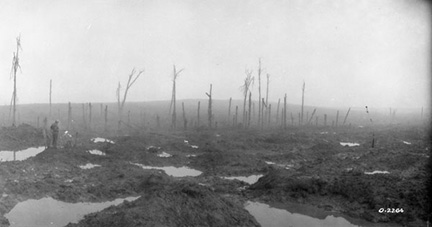
Passchendaele, now a field of mud. November, 1917. (The Battles of Ypres)
Credit: William Rider-Rider/Canada. Department of National Defence/Library and Archives Canada/PA-040141 (MIKAN no. 3643039)
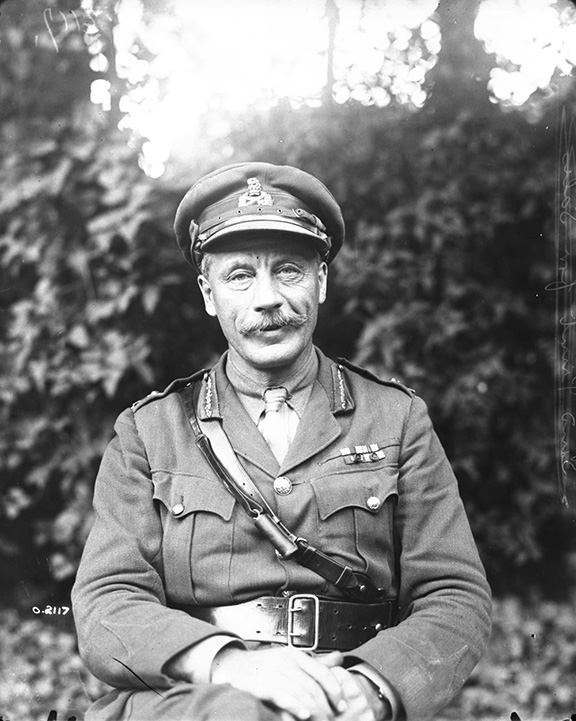
Major-General Watson, the Officer Commanding the 4th Canadian Division. Location unknown. October, 1917.
Credit: Canada. Department of National Defence/Library and Archives Canada (MIKAN no. 3222150)
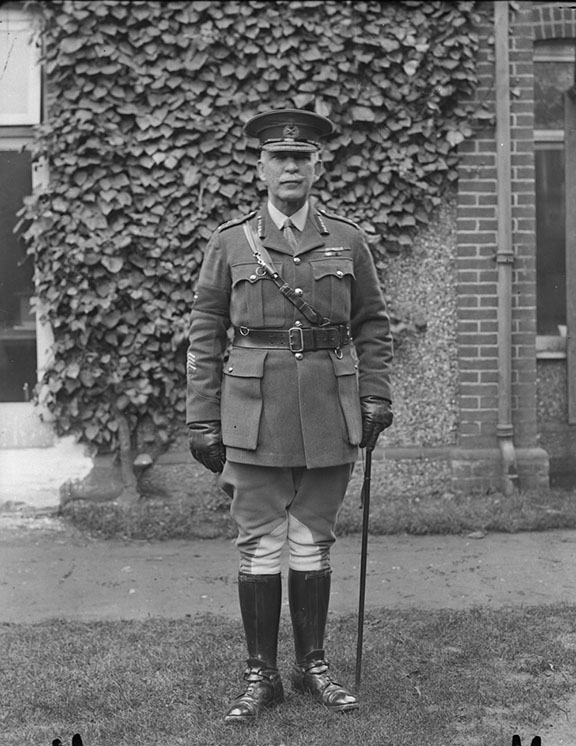
Major-General Sir Archibald Cameron Macdonell was the General Officer Commanding the 1st Canadian Division from June 1917 on. Location unknown. Date unknown.
Credit: Canada. Department of National Defence/Library and Archives Canada (MIKAN no. 3218799)
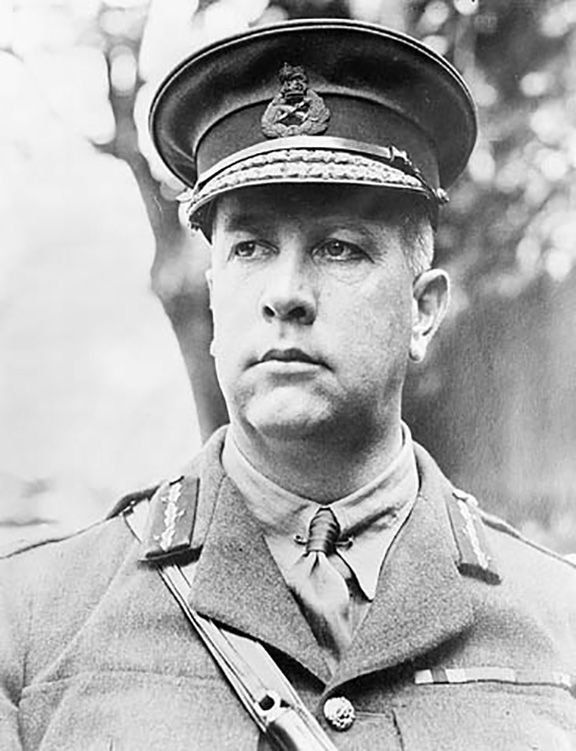
General Currie, Commander of the Canadian troops in France, and A.D.C. Location unknown. June, 1917.
Credit: Canada. Department of National Defence/Library and Archives Canada/PA-001370 (MIKAN no. 3191901)
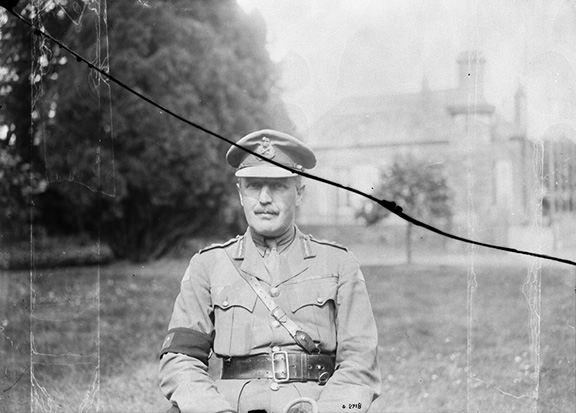
Major-General L.J. Lipsett, commander of the 3rd Canadian Division. Camblain l`Abbé. May, 1918.
Credit: Canada. Department of National Defence/Library and Archives Canada/; (MIKAN no. 3218379)
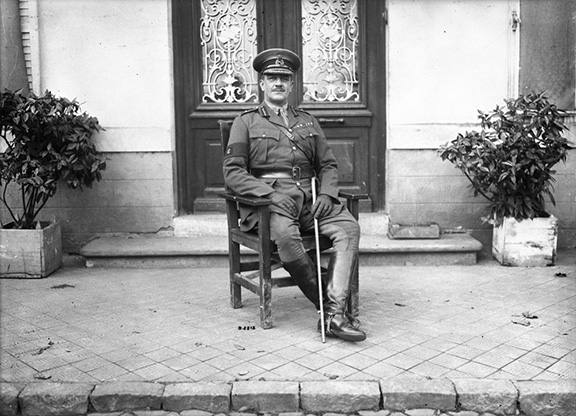
Major-General Sir Henry Edward Burstall was General Officer Commanding the 2nd Canadian Division. Location unknown. December, 1917.
Credit: Canada. Department of National Defence/Library and Archives Canada (MIKAN no. 3213482)
Awarded to:
Currently serving units
- 48th Highlanders of Canada
Awards to the 15th Canadian Infantry Battalion, CEF (GO 110/29) and The 48th Regiment (Highlanders) (GO 110/29) - 56th Field Artillery Regiment, RCA
Awards to the 4th Canadian Infantry Battalion, CEF (GO 110/29) and The Dufferin Rifles of Canada (GO 110/29) - The Argyll and Sutherland Highlanders of Canada (Princess Louise's)
Awards to the 19th Canadian Infantry Battalion, CEF (GO 110/29) and The Argyll and Sutherland Highlanders of Canada (Princess Louise's) (GO 110/29) - The Black Watch (Royal Highland Regiment) of Canada
Awards to the 13th Canadian Infantry Battalion, CEF (GO 110/29), the 42nd Canadian Infantry Battalion, CEF (GO 110/29), and The Royal Highlanders of Canada (GO 110/29) - The British Columbia Dragoons
Awards to the 2nd Canadian Mounted Rifles Battalion, CEF (GO 110/29) and The British Columbia Dragoons (GO 110/29) - The British Columbia Regiment (Duke of Connaught's Own)
Awards to the 7th Canadian Infantry Battalion, CEF (GO 71/30), the 29th Canadian Infantry Battalion, CEF (GO 123/29), the 102nd Canadian Infantry Battalion, CEF (GO 110/29), the 1st British Columbia Regiment (Duke of Connaught's Own) (GO 110/29), The North British Columbia Regiment (GO 123/29), and The Vancouver Regiment (GO 71/30) - The Calgary Highlanders
Awards to the 10th Canadian Infantry Battalion, CEF (GO 123/29) and The Calgary Highlanders (GO 110/29) - The Cameron Highlanders of Ottawa
Awards to the 38th Canadian Infantry Battalion, CEF (GO 123/29) and The Ottawa Highlanders (GO 110/29) - The Canadian Grenadier Guards
Awards to the 87th Canadian Infantry Battalion, CEF (GO 110/29) and The Canadian Grenadier Guards (GO 110/29) - The Canadian Scottish Regiment (Princess Mary's)
Awards to the 16th Canadian Infantry Battalion, CEF (GO 110/29) and The Canadian Scottish Regiment (GO 110/29) - The Cape Breton Highlanders
Awards to the 85th Canadian Infantry Battalion, CEF (GO 110/29) and The Cape Breton Highlanders (GO 110/29) - The Essex and Kent Scottish
Awards to the 18th Canadian Infantry Battalion, CEF (GO 110/29) and The Essex Scottish (GO 110/29) - Governor General's Foot Guards
Awards to the 2nd Canadian Infantry Battalion, CEF (GO 123/29) and The Governor General's Foot Guards (GO 32/32) - The Governor General's Horse Guards
Awards to the 4th Canadian Mounted Rifles Battalion, CEF (GO 110/29), The Governor General's Body Guard (GO 112/35), and The Mississauga Horse (GO 110/29) - The King's Own Calgary Regiment (RCAC)
Awards to the 50th Canadian Infantry Battalion, CEF (GO 110/29) and The Calgary Regiment (GO 110/29) - The Lake Superior Scottish Regiment
Awards to the 52nd Canadian Infantry Battalion, CEF (GO 123/29) and The Lake Superior Regiment (GO 110/29) - The Loyal Edmonton Regiment (4th Battalion, Princess Patricia's Canadian Light Infantry)
Awards to the 49th Canadian Infantry Battalion, CEF (GO 110/29) and The Edmonton Regiment (GO 110/29) - The North Saskatchewan Regiment
Awards to the 1st Canadian Mounted Rifles Battalion, CEF (GO 110/29), the 5th Canadian Infantry Battalion, CEF (GO 110/29), The Saskatchewan Mounted Rifles (GO 110/29), and The Saskatoon Light Infantry (GO 110/29) - The Nova Scotia Highlanders
Awards to the 25th Canadian Infantry Battalion, CEF (GO 123/29) and The Colchester and Hants Regiment (GO 110/29) - The Ontario Regiment (RCAC)
Awards to the 116th Canadian Infantry Battalion, CEF (GO 110/29) and The Ontario Regiment (GO 123/29) - The Princess of Wales' Own Regiment
Awards to the 21st Canadian Infantry Battalion, CEF (GO 123/29) and The Princess of Wales' Own Regiment (GO 110/29) - Princess Patricia's Canadian Light Infantry
Award to Princess Patricia's Canadian Light Infantry (GO 123/29) - The Queen's Own Cameron Highlanders of Canada
Awards to the 43rd Canadian Infantry Battalion, CEF (GO 110/29) and The Queen's Own Cameron Highlanders of Canada (GO 110/29) - The Queen's Own Rifles of Canada
Awards to the 3rd Canadian Infantry Battalion, CEF (GO 123/29) and The Queen's Own Rifles of Canada (GO 110/29) - The Queen's York Rangers (1st American Regiment) (RCAC)
Awards to the 20th Canadian Infantry Battalion, CEF (GO 110/29), the 127th Canadian Infantry Battalion, CEF (GO 71/30), The Queen's Rangers, 1st American Regiment (GO 110/29), and The York Rangers (GO 71/30) - Royal 22e Régiment
Award to the Royal 22e Régiment (GO 110/29) - The Royal Canadian Hussars (Montreal)
Awards to the 1st Canadian Motor Machine Gun Brigade, CEF (GO 110/29) and the 1st Motor Machine Gun Brigade (GO 110/29) - The Royal Canadian Regiment
Awards to the 1st Canadian Infantry Battalion, CEF (GO 110/29), The Royal Canadian Regiment (GO 110/29), and The Canadian Fusiliers (City of London Regiment) (GO 110/29) - The Royal Hamilton Light Infantry (Wentworth Regiment)
Awards to the 4th Canadian Infantry Battalion, CEF (GO 110/29) and The Royal Hamilton Light Infantry (GO 110/29) - The Royal Montreal Regiment
Awards to the 14th Canadian Infantry Battalion, CEF (GO 110/29) and The Royal Montreal Regiment (GO 110/29) - The Royal New Brunswick Regiment
Awards to the 26th Canadian Infantry Battalion, CEF (GO 110/29), The Carleton Light Infantry (GO 110/29), and The Saint John Fusiliers (GO 110/29) - The Royal Regiment of Canada
Awards to the 3rd Canadian Infantry Battalion, CEF (GO 123/29), the 58th Canadian Infantry Battalion, CEF (GO 110/29), the 123rd Canadian Pioneer Battalion, CEF (GO 123/29), the 124th Canadian Pioneer Battalion, CEF (GO 123/29), The Royal Grenadiers (GO 110/29), and The Toronto Regiment (GO 110/29) - The Royal Regina Rifles
Awards to the 28th Canadian Infantry Battalion, CEF (GO 110/29) and The Regina Rifle Regiment (GO 110/29) - The Royal Westminster Regiment
Awards to the 47th Canadian Infantry Battalion, CEF (GO 110/29) and The Westminster Regiment (GO 110/29) - The Royal Winnipeg Rifles
Awards to the 8th Canadian Infantry Battalion, CEF (GO 110/29), the 10th Canadian Infantry Battalion, CEF (GO 123/29), the 27th Canadian Infantry Battalion, CEF (GO 123/29), the 44th Canadian Infantry Battalion, CEF (GO 110/29), The Winnipeg Rifles (GO 110/29), and The Winnipeg Light Infantry (GO 110/29) - The Saskatchewan Dragoons
Awards to the 46th Canadian Infantry Battalion, CEF (GO 110/29) and The King's Own Rifles of Canada (GO 110/29) - The Seaforth Highlanders of Canada
Awards to the 72nd Canadian Infantry Battalion, CEF (GO 5/31) and The Seaforth Highlanders of Canada (GO 5/31) - The Sherbrooke Hussars
Awards to the 5th Canadian Mounted Rifles Battalion, CEF (GO 110/29) and the 7th/11th Hussars (GO 10/39) - The South Alberta Light Horse
Awards to the 31st Canadian Infantry Battalion, CEF (GO 110/29) and The South Alberta Regiment (GO 110/29) - The Toronto Scottish Regiment (Queen Elizabeth The Queen Mother's Own)
Awards to the 75th Canadian Infantry Battalion, CEF (GO 110/29) and The Toronto Scottish Regiment (GO 110/29)
Units on the Supplementary Order of Battle
- 24th Field Artillery Regiment, RCA
Awards to the 54th Canadian Infantry Battalion, CEF (GO 110/29) and The Kootenay Regiment (GO 110/29) - 27th Field Artillery Regiment, RCA
Award to The Eastern Townships Mounted Rifles (GO 110/29) - 50th Field Artillery Regiment (The Prince of Wales' Rangers), RCA
Awards to the 2nd Canadian Infantry Battalion, CEF (GO 123/29) and The Peterborough Rangers (GO 110/29) - 118th Medium Battery, RCA
Awards to the 1st Canadian Mounted Rifles Battalion, CEF (GO 110/29) and The Manitoba Mounted Rifles (GO 5/31) - Victoria Rifles of Canada
Awards to the 24th Canadian Infantry Battalion, CEF (GO 110/29) and The Victoria Rifles of Canada (GO 110/29) - The Winnipeg Grenadiers
Awards to the 78th Canadian Infantry Battalion, CEF (GO 110/29) and The Winnipeg Grenadiers (GO 110/29)
Disbanded Units
- 1st Canadian Pioneer Battalion, CEF
Award to the 1st Canadian Pioneer Battalion, CEF (GO 88/31) - 2nd Canadian Pioneer Battalion, CEF
Award to the 2nd Canadian Pioneer Battalion, CEF (GO 123/29) - 107th Canadian Pioneer Battalion, CEF
Award to the 107th Canadian Pioneer Battalion, CEF (GO 123/29) - The Manitoba Regiment
Award to The Manitoba Regiment (GO 123/29) - The North Alberta Regiment
Awards to the 31st Canadian Infantry Battalion, CEF (GO 110/29) and The North Alberta Regiment (GO 110/29)